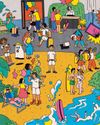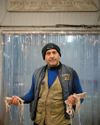How Did Boeing, Renowned For Its Engineering Culture, End Up In Such A Tailspin? By Putting Its Bottom Line Above All Else

THE SIMULATORS IN WHICH PILOTS TRAIN TO FLY airliners are engineering marvels in themselves. Picture a squat pod raised 10 feet in the air and mounted on spider legs that let the whole contraption move up, down, left, right, forward, and back. To meet Federal Aviation Administration requirements, the pilots sitting inside must be shown a realistic representation of what they’d see outside a real cockpit, so images are projected onto a curved mirror. Many simulators use cinema-quality sound to create a cacophony of alerts and warnings. Each machine costs $15 million or more, and airlines pay hundreds of dollars an hour for pilots to use one.
As Boeing Co. developed the 737 Max, the newest version of its most profitable and now most infamous plane, engineers repeatedly invited FAA officials to look over their designs in one of the company’s Seattle simulators—an even more realistic mock-up built from pieces of actual aircraft. One purpose was to find out how to ensure that pilots switching to the new plane from previous 737 models never had to get inside one and take what’s known as Level D training. “We showed them all these scenarios, and then we’d ask, ‘Would this change equal Level D?’ ” recalls former Boeing engineer Rick Ludtke.
Boeing got what it wanted: Pilots moving from a 737-800 to a 737 Max would need at most Level B training, which they could complete in an hour or two on an iPad. That let airlines deploy the $120 million plane more quickly. For Boeing, it was an important selling point that gave customers one less reason to defect to its European rival Airbus SE.
この記事は Bloomberg Businessweek の May 13, 2019 版に掲載されています。
7 日間の Magzter GOLD 無料トライアルを開始して、何千もの厳選されたプレミアム ストーリー、9,000 以上の雑誌や新聞にアクセスしてください。
すでに購読者です ? サインイン
この記事は Bloomberg Businessweek の May 13, 2019 版に掲載されています。
7 日間の Magzter GOLD 無料トライアルを開始して、何千もの厳選されたプレミアム ストーリー、9,000 以上の雑誌や新聞にアクセスしてください。
すでに購読者です? サインイン

Instagram's Founders Say It's Time for a New Social App
The rise of AI and the fall of Twitter could create opportunities for upstarts

Running in Circles
A subscription running shoe program aims to fight footwear waste

What I Learned Working at a Hawaiien Mega-Resort
Nine wild secrets from the staff at Turtle Bay, who have to manage everyone from haughty honeymooners to go-go-dancing golfers.

How Noma Will Blossom In Kyoto
The best restaurant in the world just began its second pop-up in Japan. Here's what's cooking

The Last-Mover Problem
A startup called Sennder is trying to bring an extremely tech-resistant industry into the age of apps

Tick Tock, TikTok
The US thinks the Chinese-owned social media app is a major national security risk. TikTok is running out of ways to avoid a ban

Cleaner Clothing Dye, Made From Bacteria
A UK company produces colors with less water than conventional methods and no toxic chemicals

Pumping Heat in Hamburg
The German port city plans to store hot water underground and bring it up to heat homes in the winter

Sustainability: Calamari's Climate Edge
Squid's ability to flourish in warmer waters makes it fitting for a diet for the changing environment

New Money, New Problems
In Naples, an influx of wealthy is displacing out-of-towners lower-income workers